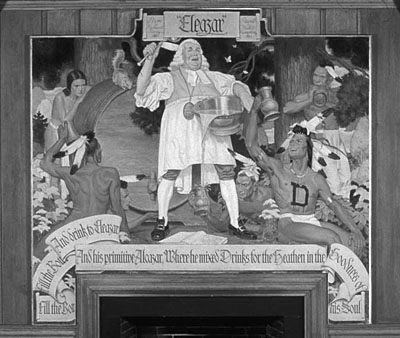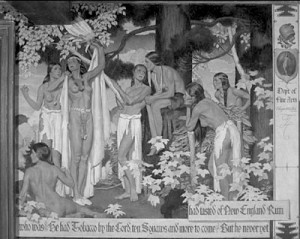
Fill the Bowl Up with Settler Colonialism
Picture Caption: Hovey Mural
Fill the bowl up!
Fill the bowl up! Drink to Eleazar
And his primitive Alcazar
Where he mixed drinks for the heathen,
In the goodness of his soul.
The big chief that met him was the
sachem of the Wah-hoo-wahs.
If he was not the big chief,
there was never one you saw who was;
He had tobacco by the cord,
ten squaws, and more to come,
But he never yet had tasted
of New England rum.
The history of colonialism in Dartmouth’s history is undeniable. However these instances of racial insensitivity do not remain in the past but rather are carried on today, with honor and in the name of “school pride.” The lyrics above are part of a song coined by Richard Hovey, a Dartmouth graduate of 1885. They imply that the Abenaki, the tribe whose land Dartmouth is built on, had traded in their lands for some New England rum. The song is littered with primitive portrayals of the Abenaki, reducing their language to a simple “Wah-hoo-wah” and their culture into one easily bought by alcohol. As if the song wasn’t enough, Hovey went on to illustrate the song in a mural, located under what is currently the Class of 1953 Commons dining hall. The mural is a response to the Orozco murals, which display the legacies of settler colonialism by portraying Wheelock as a jolly, Santa-like figure pouring rum for Abenaki women and men. Once again, the Abenaki are portrayed as foolish followers of Wheelock as they demand more rum, read books upside down and walk around with giant green D’s painted on their chests. In 2006, students called for the removal of the murals from Dartmouth; however, this demand was denied because the administration felt it was necessary to confront the institution’s flawed history. And yet, the administration has also succeeded in oppressing its existence by keeping it in a closed room that is never highly publicized or made known, despite the administration’s past promise to “acknowledge its presence.” Even though Dartmouth was made for Native students, its continued portrayal of Native people as barbaric and unintelligent continues an institutional oppression that reveals Dartmouth will never really be for them.
Caption: Hovey Mural; taken by The Dartmouth Review
